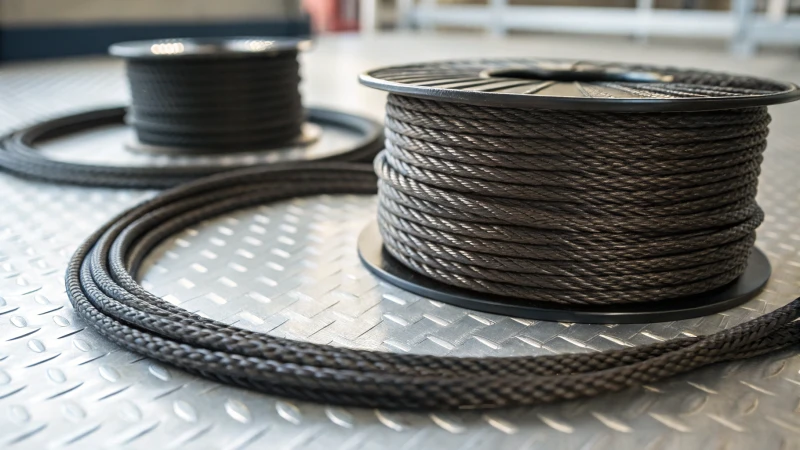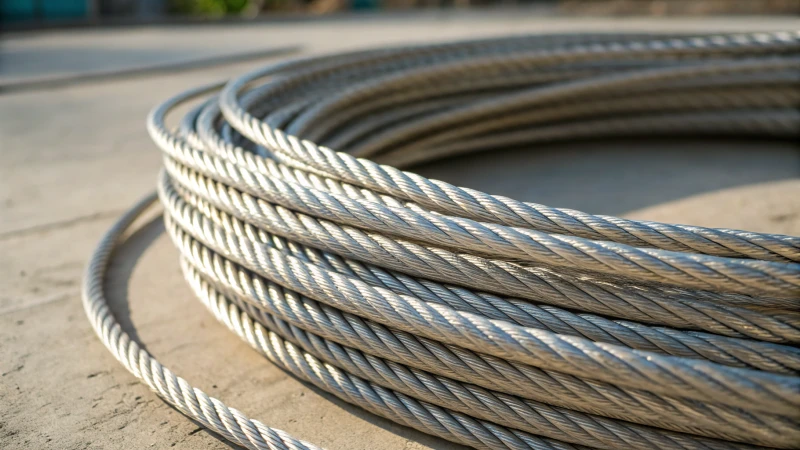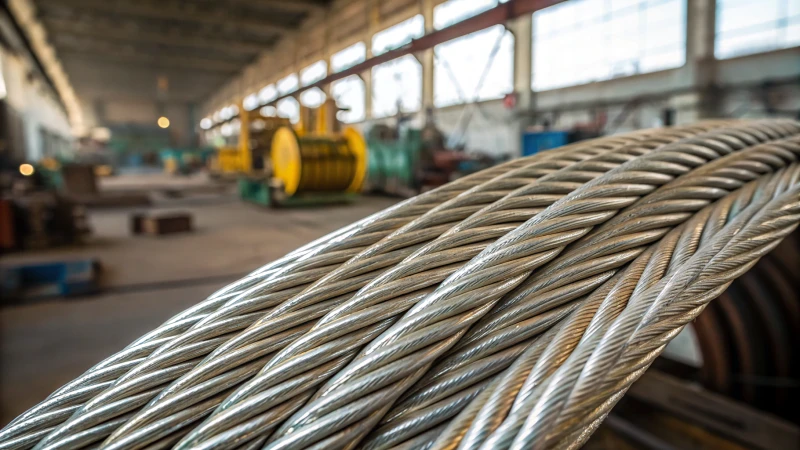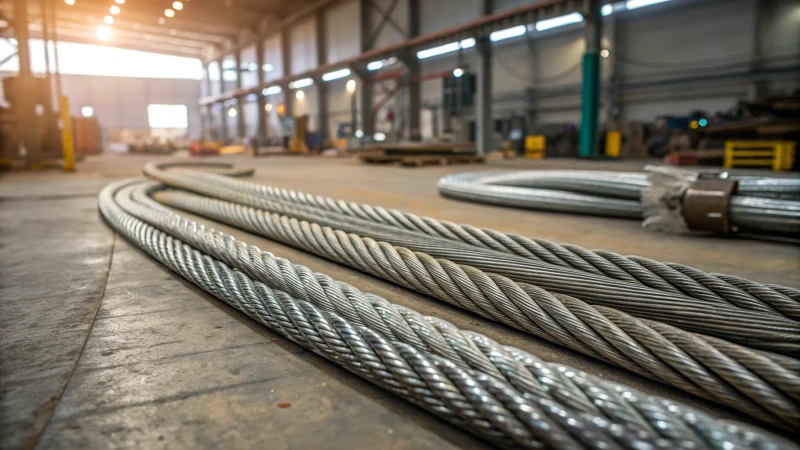
I still remember the first time I saw a massive crane in action, effortlessly lifting tons of steel with a grace that seemed almost unnatural.
Steel wire ropes are impressively flexible, ideal for heavy machinery tasks. Their design facilitates smooth winding and unwinding, minimizing wear on parts and ensuring seamless operations.
As I delved deeper into the world of heavy machinery, it became clear that the flexibility of steel wire ropes isn't just a technical detail—it's a game-changer. Imagine a massive construction site where every minute counts. The last thing anyone needs is equipment failure. That's where the flexibility of these ropes shines, as they adapt to every twist and turn of the job, reducing strain and prolonging machine life. It's like having a reliable old friend who's always got your back, no matter how tough things get.
Steel wire ropes reduce wear on machine components.True
Their flexibility allows smooth winding and unwinding, reducing wear.
Steel wire ropes are inflexible in heavy machinery applications.False
They offer exceptional flexibility, ideal for heavy machinery use.
What Makes Steel Wire Rope Flexible?
Ever wondered why some steel wire ropes bend like a gymnast while others are as stiff as a board? Let me take you on a journey through their flexible world.
Steel wire rope flexibility is determined by the number of wires in each strand, the strand patterns, and the core material. A higher number of wires and certain patterns increase flexibility, enhancing performance.

The Role of Wire Count and Diameter
I remember when I first started working with steel wire ropes; it was a bit like learning a new language. The number of wires in each strand can significantly impact flexibility. More wires mean greater flexibility because finer wires1 bend more easily. It's like comparing a bundle of straws to a single thick stick—more straws allow more bending. For example, a 6x36 construction with 36 wires per strand offers more flexibility than a 6x19 construction.
| Construction | Wire Count per Strand | Flexibility |
|---|---|---|
| 6x19 | 19 | Moderate |
| 6x36 | 36 | High |
Influence of Strand Patterns
The first time I heard about strand patterns, I imagined them like intricate braids. Some patterns, like Warrington or Seale, are designed for enhanced flexibility without compromising strength. The Warrington pattern2 alternates larger and smaller wires, allowing more movement and bending—it's like watching a well-choreographed dance.
Core Material Variations
The core of the rope plays a pivotal role too. While steel cores provide strength, they aren't as bendy. On the other hand, fiber cores offer more flexibility but less strength. Depending on what you need—say, for applications where bending is crucial—a fiber core might be your best friend.
Advancements in Manufacturing Techniques
In today's world, technological advances have introduced hybrid ropes that blend fiber and steel cores. These innovative designs3 strike a balance between strength and flexibility, like getting the best of both worlds. Plus, some ropes now have plastic coatings that enhance their bending properties even more.
Applications Requiring High Flexibility
In industries like construction and mining, flexibility is not just a nice-to-have; it's essential. Imagine trying to wind and unwind without putting stress on machinery parts—it's like trying to move in a tight space without bumping into things. Understanding these elements helps in selecting steel wire ropes that meet specific needs across different applications.
6x36 wire rope is more flexible than 6x19.True
6x36 has more wires per strand, enhancing flexibility compared to 6x19.
Steel cores offer higher flexibility than fiber cores.False
Fiber cores are more flexible, while steel cores provide greater strength.
How Does Flexibility Impact Machinery Performance?
When I first started working with heavy machinery, I quickly learned that flexibility isn't just a human trait—it's crucial for machines too. Discovering its impact on performance was a game-changer.
Flexibility in machinery, like flexible steel wire ropes, reduces wear, boosts maneuverability, and enhances operational efficiency. This adaptability leads to smoother operations and extends machinery lifespan by minimizing stress and friction.

The Role of Flexibility in Machinery
Remember the first time you tried to fit a rigid piece of wire into a tight space? It probably didn't go well. That's where flexibility in machinery comes in, adapting components to varying demands without a hitch. Take flexible steel wire ropes4, for example—they're a lifesaver in industries like construction and mining.
Benefits of Flexible Components
Flexible components act like the shock absorbers in your car. They cushion the blow, absorbing vibrations and shocks to reduce wear on mechanical parts. This means longer machinery life and fewer maintenance headaches.
| Feature | Impact |
|---|---|
| Vibration Absorption | Reduces mechanical wear |
| Shock Resistance | Minimizes operational downtime |
| Enhanced Maneuverability | Facilitates smoother machine operations |
Applications Across Industries
In my experience in construction, using flexible steel wire ropes has made lifting operations smoother than ever. And in mining, these ropes are essential for maneuvering in tight spaces. They can take a beating from harsh conditions without breaking a sweat.
Technological Advancements
Thanks to advancements in materials, we've got highly flexible yet strong ropes on our hands. These developments answer the call for efficiency and durability in modern machinery.
- Enhanced Materials: New alloys and coatings improve flexibility without losing strength.
- Innovative Designs: Engineers are crafting more adaptable components to meet specific industry needs.
Flexibility's Future in Machinery
As industries evolve, the demand for flexible machinery components is only going to rise. By focusing on flexibility, we're looking at improvements in efficiency, safety, and cost-effectiveness.
Manufacturers who invest in innovative flexible solutions5 are poised to lead the market, offering products that meet rigorous operational standards while catering to diverse industrial needs.
Flexible components reduce machinery maintenance costs.True
Flexibility absorbs shocks and vibrations, lessening wear on parts.
Inflexible machinery components enhance operational efficiency.False
Inflexibility increases wear and limits adaptability, reducing efficiency.
What Are the Different Types of Steel Wire Ropes?
Ever find yourself tangled up in the world of steel wire ropes, wondering which one’s right for your project?
Steel wire ropes come in stainless steel, galvanized, and ungalvanized forms, each offering specific benefits like corrosion resistance or superior strength. Choosing the right type depends on your specific industrial needs and environmental conditions.

Stainless Steel Wire Ropes
Stainless steel wire ropes are the heroes when it comes to battling corrosion6. I remember the first time I had to source these for a project near the ocean. The salty air was merciless, but these ropes held their ground, proving invaluable for marine applications.
| Advantages | Applications |
|---|---|
| High corrosion resistance | Marine, architecture |
| Aesthetic appearance | Food processing machinery |
Galvanized Steel Wire Ropes
Galvanized ropes are like the trusty, budget-friendly option that doesn’t compromise too much on performance. They remind me of that zinc-coated toolbox my dad gave me—it wasn’t the fanciest, but it got the job done without rusting away.
| Benefits | Common Uses |
|---|---|
| Affordable protection | Cranes, elevators |
| Good for outdoor use | Mining equipment |
Ungalvanized Steel Wire Ropes
These ropes are all about raw strength and flexibility. Picture a gymnast: no extra layers but built strong and flexible. Perfect for situations where regular maintenance keeps them rust-free.
Ungalvanized ropes, while lacking a protective zinc coating, are known for their superior strength and flexibility. They find applications in controlled indoor settings where strength is critical.
Coated Steel Wire Ropes
When you need something smooth and durable, coated ropes with PVC or nylon are your go-to. They’re like putting a protective case on your phone—added protection without sacrificing functionality.
Coated ropes feature a layer of PVC or nylon, enhancing their flexibility and resistance to wear. Such coatings make them suitable for applications requiring7 smooth operation without compromising the rope's strength.
| Coating Types | Benefits |
|---|---|
| PVC | Increased flexibility |
| Nylon | Enhanced wear resistance |
In my experience, selecting the right type involves balancing factors like environment, load requirements, and budget. Each rope offers unique features that could make or break your project’s success. So take it from someone who's been there: make sure to match your rope choice with your specific needs.
Stainless steel ropes are ideal for food processing.True
Stainless steel's corrosion resistance makes it suitable for food environments.
Ungalvanized ropes are best for outdoor use.False
Ungalvanized ropes lack protective coating, making them unsuitable outdoors.
Why Choose Steel Wire Ropes Over Other Materials?
I remember the first time I watched a towering crane effortlessly lift massive steel beams into place, all thanks to those incredible steel wire ropes. What makes them such a game-changer in tough environments? Let's dive into the unbeatable advantages they offer.
Steel wire ropes stand out for their incredible strength, flexibility, and longevity. Unlike synthetic options, they handle high stress, resist corrosion, and perform reliably in harsh conditions, making them the top choice for demanding tasks.

Strength and Durability
Steel wire ropes are like the unsung heroes of heavy industry. I mean, picture this: you've got a massive project deadline looming, and your equipment needs to handle loads that could make Hercules sweat. That's where these ropes shine—they're built to withstand extreme tension without breaking a sweat.
| Material | Tensile Strength (MPa) |
|---|---|
| Steel | 1,770 - 2,160 |
| Nylon | 75 - 100 |
| Polyester | 100 - 150 |
Their impressive tensile strength means fewer sleepless nights worrying about safety and reliability8.
Flexibility and Adaptability
When I first saw how flexible steel wire ropes are, it was like watching an acrobat perform. Their ability to bend and twist without losing strength is crucial, especially when cables have to be wound and unwound in machinery. It's this flexibility that keeps machines running smoothly, reducing wear and enhancing operational efficiency9.
Resistance to Harsh Conditions
Imagine being out at sea, with salty waves crashing around you, and still needing your equipment to perform flawlessly. That's a regular day for steel wire ropes. Galvanized or coated, they resist corrosion like a knight's armor against rust dragons, perfect for marine and offshore operations facing relentless saltwater exposure10.
Cost-Effectiveness
Now, I won't sugarcoat it—the initial cost might be higher than some alternatives. But think of it like investing in a good pair of boots that last for years. With their durability and low maintenance needs, steel wire ropes often save money in the long run.
Versatility in Applications
Steel wire ropes are like the Swiss Army knife of materials—adaptable and ready for anything. From construction to mining, their versatility is unmatched. They can be customized with coatings or different core materials to meet specific requirements.
For example, stainless steel options11 excel in corrosion resistance, while fiber core variants offer extra flexibility. This adaptability makes them the go-to for countless sectors.
Steel wire ropes have higher tensile strength than nylon.True
Steel wire ropes have tensile strength of 1,770-2,160 MPa, nylon 75-100.
Nylon ropes are more resistant to corrosion than steel.False
Steel wire ropes have excellent corrosion resistance when galvanized or coated.
Conclusion
Steel wire ropes offer exceptional flexibility, strength, and durability for heavy machinery applications, enhancing operational efficiency and reducing wear on components in demanding environments like construction and mining.
-
Explores the mechanics of how increased wire count improves flexibility by allowing easier bending. ↩
-
Describes how the Warrington pattern enhances flexibility with alternating wire sizes. ↩
-
Discusses how hybrid designs offer a balance between strength and flexibility. ↩
-
Explore how flexible steel wire ropes enhance machinery performance by reducing wear and improving operational efficiency. ↩
-
Discover the latest innovations in flexible machinery components and their potential impact on industry efficiency. ↩
-
Discover how stainless steel wire ropes offer exceptional corrosion resistance, making them suitable for harsh environments. ↩
-
Explore how coated steel wire ropes enhance flexibility and wear resistance, perfect for smooth operation. ↩
-
Clicking this link provides insights into why steel wire ropes are chosen for their superior tensile strength, crucial for safety and reliability. ↩
-
Discover how the flexibility of steel wire ropes enhances machinery performance, reducing wear and improving efficiency. ↩
-
Learn about the corrosion resistance properties of galvanized steel wire ropes, essential for marine applications. ↩
-
Explore the unique applications of stainless steel wire ropes that offer excellent corrosion resistance. ↩

